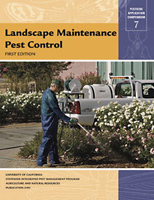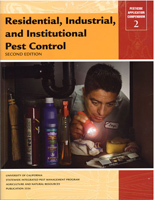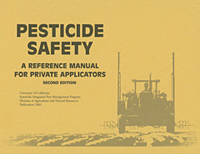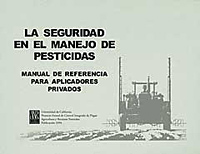|
|
2006
Annual Report
UC Statewide IPM Program
HIGHLIGHTS |
 Landscape Maintenance Pest Control Landscape Maintenance Pest Control
UC IPM has released Landscape Maintenance Pest Control, a guide to using
pesticides safely in turf, landscape, and interior situations ranging from
parks and golf courses to indoor malls.
Designed for professionals working in the public or private sector, the
guide released by the UC IPM Program focuses especially on pesticide handling
and application procedures of importance. More than 200 photos, line drawings,
graphs, and sidebars illustrate key concepts and procedures.
The book is recommended study material for Landscape Maintenance Pest
Control and Maintenance Gardener categories of the California Department
of Pesticide Regulation’s Qualified Pesticide Applicator License
and Qualified Pesticide Applicator Certificate exams. Review questions
similar to those on the exams are included at the end of each chapter.
For complete information on integrated pest management, biology, and identification
of pests of landscape trees and shrubs, see Pests of Landscape Trees and
Shrubs.
Landscape Maintenance Pest Control is the seventh volume in the UC IPM
Pesticide Application Compendium. Others are:
- Volume
1, The Safe and Effective Use of Pesticides, second edition, published
in February 2000.
- Volume
2, Residential, Industrial, and Institutional Pest Control, second
edition, published in 2006.
- Volume
3, Wood Preservation, published in 1992.
- Volume
4, Forest and Right-of-Way Pest Control, published in 1996.
- Volume
5, Aquatic Pest Control, published in January 2001.
- Volume
6, Demonstration and Research Uses of Pesticides, published in
August 2003.
To order, contact ANR Publications, 1-800-994-8849, or www.anrcatalog.ucdavis.edu Ask for publication 3493.
 UC IPM releases indoor pest management guide UC IPM releases indoor pest management guide
Shielding school children from harmful pesticides is just one of the many
features in the second edition of Residential, Industrial,
and Institutional Pest Control by UC IPM.
The book highlights new information for carrying out environmentally friendly
IPM programs in and around schools and other public and private buildings.
Topics include how to select appropriate pesticides, how to monitor for
pests, and how to effectively use safe control tools such as cockroach
and ant baits, traps, and sanitation practices.
With more than 60 pests covered, the manual contains tips on using gel
baits for cockroaches, removing bees from walls in buildings, applying
repellants for relief from mosquitoes, and ways to identify common household
ants. Information on many new pests, including booklice, carpenter
bees, and carpenter ants, has been added to this completely revised edition.
The latest techniques and pest management tools, as well as review questions
to help those studying for the California Department of Pesticide Regulation
(DPR) and Structural Pest Control Board exams, also are included in the
book. It is the recommended study guide for California DPR’s Qualified
Applicator Certificate and Qualified Applicator License examinations in
the Residential, Industrial, and Institutional Pest Control category.
Chapter 2 of the book, “Using Pesticides Safely,” specifically
addresses ways to protect workers by using proper application techniques
and is a helpful reference for applicators trying to comply with proposed
regulations to protect themselves and others.
The reference book is Volume 2 in the Pesticide Application
Compendium series, a seven-book collection that belongs on the bookshelves of anyone
who uses pesticides, supervises their use, or instructs others in the proper
use of pesticides.
For more information, visit the UC
IPM Web site.
Top of page
Pesticide safety book
The UC Statewide IPM Program has completely updated two valuable books
for growers’ bookshelves—Pesticide Safety: A Reference Manual
for Private Applicators (publication 3383) and the Spanish translation Seguridad
en el manejo de pesticidas Manual de referencia para aplicadores privados,
publication 3394.
Essential for anyone using pesticides on California farms, Pesticide Safety
is recommended by the Department of Pesticide Regulation as a study guide
for the California certified private applicator examination.
Topics covered include pesticide safety practices important to growers,
farm managers, and employees. A special feature is the Farm Profile section
that guides growers through the steps required to identify unique conditions
on their farms and safety procedures that must be followed when using pesticides
to protect health and the environment.
Chapters cover pesticide labels; mixing and applying pesticides (including
calibration); recognizing and avoiding pesticide hazards; and proper responses
to pesticide emergencies. The appendix includes a pesticide application
checklist, resource lists, sample training forms for pesticide handlers
and fieldworkers, and information on avoiding heat-related illness. Review
questions and answers are included for each chapter.
Next article >> Web
only: More new publications
Top of page
|




